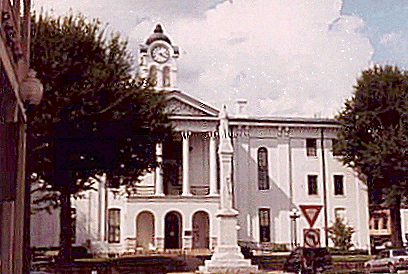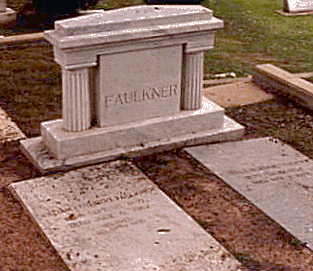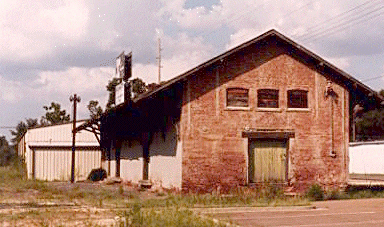Description of Map Sites
Click on any numbered location below to return to the map.
1.
The Thompson-Chandler House.
Built around 1838 but vacant today, this house was the model for the Compson place in The Sound and the Fury. According to later owners, the original cottage is believed to have been built by John D. Martin, one of the three land speculators and founders of Oxford. |
|||
|
2.
The Oldham House.
Approximate location of Estelle Oldham's family's house. |
|||
|
This city block was the site of "The Big Place," the house built by William Faulkner’s grandfather J.W.T. Falkner, also known as the "Young Colonel." (Faulkner’s great-grandfather, William Clark Falkner, was the "Old Colonel.") After he sold a portion of the lot on University Ave. to the Standard Oil Company (today it is a Chevron station), another house was built in 1932 by Murry Falkner, William's father. This was the home for William's mother, Maud Butler Falkner. Today, a concrete block at the bottom of the steps down to the street has the name "Falkner" carved on the blocks with the "N" turned backward. The blocks and the house lot are all that is left of the Colonel's estate.
|
|||
The courthouse square has
been the center of Oxford social life since the city was founded in 1837.
The original Lafayette County Courthouse was built in 1840, but it was
burned in 1864 by Union troops led by Gen. A.J. "Whiskey" Smith.
The present building dates from 1873 and was designated a National
Historic Monument in 1977. A statue of a Confederate soldier looks down
South Lamar Ave., as depicted in The Sound and the
Fury. Also located on the Courthouse square is a World War II
memorial featuring two lines Faulkner wrote:
|
|||
|
5.
First National Bank of Oxford.
J.W.T. Falkner founded the First National Bank in 1910 in the smaller building to the east. William Faulkner used it as the Sartoris Bank in two novels, Flags in the Dust (first published as Sartoris) and The Unvanquished. The building housed a funeral home, then a men's clothing store, and today is Duvall's, a women's clothing store. First National Bank is now located in the larger building next door. |
|||
6.
Phil Stone's Law Office.
Phil Stone was an early admirer of Faulkner’s writing who encouraged him to pursue his craft. Built in the 1860s, this building is said to be one of the oldest continuing law office structures in Mississippi. Today, it is the office for the firm Freeland & Freeland, Lawyers.
|
|||
|
7-9.
St. Peter's Cemetery.
Most of the Faulkner family is buried here, in separate locations.
7. The Falkner family plot: J.W.T. and Sallie Murry Falkner (Faulkner’s grandparents), Murry C. and Maud Butler Falkner (his parents), his brother Dean, his infant daughter Alabama, and several other relatives. 8. John and Lucille (Dolly) Fa(u)lkner (Faulkner’s brother): This gravestone is interesting because the family could not agree on a spelling of the last name. It is spelled "Falkner" on one side of the stone and "Faulkner" on the other. 9. William Faulkner gravesite: His wife Estelle and stepson Malcolm Franklin are also buried here under marble gravestones. The fourth gravesite in the plot, which hand long been vacant, has in recent years been filled by a smaller stone for "E.T.," who is described as "an old family friend who came home to rest with us." The identity of "E.T." is a carefully guarded secret; no one seems to know who "E.T." is, except for Faulkner’s nephew, Jimmy Faulkner. |
|||
|
Built around 1859 and designed by well-known architect Calvert Vaux, this Italianate villa is an excellent model for the Benbow house in Sartoris. The house was used as the home of a character in the 1950s MGM movie Home from the Hills, filmed in Oxford. |
|||
The depot building still stands, old and decrepit, next to a parking lot now used by commuter students at Ole Miss. In its day, however, it was a passenger depot on the Illinois Central Railroad, the main line connecting Chicago to New Orleans (and made famous by Arlo Guthrie in the song "City of New Orleans"). Sadly, today no trains come through Oxford anymore; parts of the track were demolished south of here. One other interesting note is that the railroad cut just south of the Depot (where the University Avenue bridge crosses over the rail line) was dug by slaves in the 1850s. |
|||
|
This is where the Faulkners lived before William bought Rowan Oak; he wrote As I Lay Dying in this house. The house is named for the second owner's daughter, who as a student at the University of Missippi in 1896 won a contest to name the annual. She submitted "Ole Miss" and that has become the name the whole university is known by today. |
|||
|
The home of John and Lucille "Dolly" Falkner. John, whose nickname was "Johncy," was William's bother; he wrote a book on Faulkner called My Brother Bill: An Affectionate Reminiscence, pubished in 1963, the year after Faulkner’s death. Currently this house is the location of the University of Mississippi Foundation. |
|||
|
14.
Rowan Oak.
Today it is a museum operated by the University of Mississippi English Department. It is open to the public Tuesday through Saturday from 10 a.m. to noon and from 2 to 4 p.m., and on Sunday from 2 to 4 p.m. It is closed on Mondays. |
Other Map Locations
I've listed a few other locations on the map that aren't Faulkner-related per se, but which nonetheless are interesting landmarks in their own right.
Neilson's Department Store: The oldest department store in the South and the sixteenth oldest in the nation. Originally it was a log cabin trading post built north of the present square in 1839 by W.S. Neilson, it was the first business in Oxford. The present building was built by the son of W.S. Neilson in 1897. According to legend, Faulkner based the Emily Grierson of "A Rose for Emily" upon a Neilson daughter who married a Yankee.
Oxford City Hall: This structure, built in 1885, was Oxford's first federal building.
Square Books: The building is said to be one of the first built in Oxford after the Civil War. Today it is a bookstore and coffeeshop and is generally regarded as one of the finest bookstores in the nation.
Devoe's Gathright-Reed Drug Company: When this drugstore was located next to Faulkner Alley during Faulkner’s childhood and adolescence, Mr. Mac Reed had a lending library of paperback books, mostly mysteries, which Faulkner regularly checked out. Later, when Faulkner began publishing books, Mac Reed's drugstore was one of the only places in town readers could purchase Faulkner’s books.
Finally, one place worth mentioning that is not located on the map but is nonetheless (and surprisingly) an interesting place for Faulknerphiles is the McDonald's restaurant located on University Ave. near State Highway 7. The interior decor of the restaurant is actually a museum, with numerous informational displays, photographs, and artifacts relating to Faulkner, the early history of Oxford, and the University of Mississippi. It is definitely worth a visit. (Note: there are now two McDonald's in Oxford -- the second, located on Jackson Ave., does not have any worthwhile displays.) N
Oxford Tourism Council
P.O. Box 965
Oxford, Mississippi 38655
Telephone (601) 234-4680
Disclaimer: Contents of this page are not affiliated with the Oxford Tourism Council, the city of Oxford, or Lafayette County.











